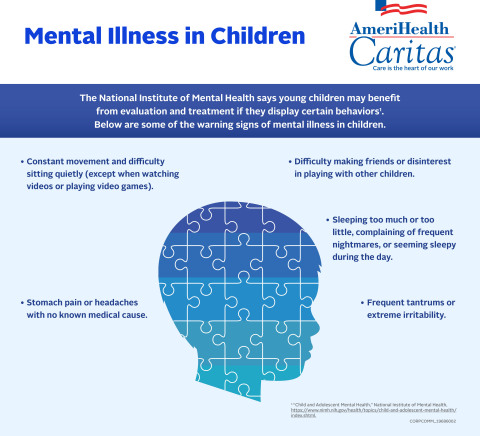PHILADELPHIA--(BUSINESS WIRE)--It may be surprising to learn that almost as many children as adults have mental illness1. Distinguishing between normal childhood behavior and behavior that indicates something more serious can be difficult, however. Parents are advised to also look for signs in a child’s nonverbal cues and behaviors, as delaying necessary treatment can produce broader developmental challenges.
“Unlike adults who are able to verbalize their feelings, based on their stage of development, children may not be able to communicate how they are feeling -- they often do so through behaviors,” said Kamilah Jackson, M.D., M.P.H., a medical director at AmeriHealth Caritas, a national leader in Medicaid managed care and other health care solutions for those most in need. “Therefore, you can imagine the challenges that screening children with mental illness may present.”
According to the National Alliance on Mental Illness (NAMI), about one in five children ages 13 to 18 experiences a severe mental disorder at some point in their lifetime. Mental health challenges can and do affect all children, regardless of socioeconomic status. However, children who experience significant stressful life events, and those dealing with key social barriers to their well-being, such as unstable housing, financial insecurity, and unsafe neighborhoods, can be especially vulnerable.
Risk factors for many common mental disorders are heavily associated with social inequalities, according to the World Health Organization:2
- Only half of the children ages 6 to 17 with a mental health condition have received treatment in the prior year.
- Among children living below 100% of the federal poverty level, more than one in five (22%) had a mental, behavioral, or developmental disorder3.
- Fifty percent of all lifetime mental illness begins by age 14, and 75% by age 244.
“It’s crucial to understand that mental illness in children is as important to attend to as a physical illness and must be treated,” said Dr. Jackson. “A first step is to recognize the warning signs.”
The National Institute of Mental Health says young children may benefit from evaluation and treatment if they display certain behaviors:5
- Constant movement and difficulty sitting quietly (except when watching videos or playing videogames)
- Frequent tantrums or extreme irritability
- Complaints of stomach or headaches with no known medical cause
- Difficulty making friends or not interested in playing with other children
- Sleeps too much or too little, complains of frequent nightmares, or seems sleepy during the day
“Should parents see these warning signs, they should speak with their pediatrician, see a mental health specialist, and consider joining a support group or otherwise connecting with other families,” added Dr. Jackson. “It’s also a good idea to work closely with your child’s school to learn what programs can help them. There is hope for children with mental health challenges and they can be successfully treated and develop into healthy, productive adults.”
About AmeriHealth Caritas Family of Companies
AmeriHealth Caritas is one of the nation’s leaders in health care solutions for those most in need. Operating in 13 states and the District of Columbia, AmeriHealth Caritas serves approximately 4 million Medicaid, Medicare and Children’s Health Insurance Program (CHIP) members through its integrated managed care products, pharmaceutical benefit management and specialty pharmacy services, and behavioral health services. Headquartered in Philadelphia, AmeriHealth Caritas is a mission-driven organization with more than 35 years of experience serving low-income and chronically ill populations. For more information, visit www.amerihealthcaritas.com.
___________________________
1National Alliance on Mental Illness. “Mental Health by the Numbers.” Accessed Sept. 5, 2019. https://www.nami.org/Learn-More/Mental-Health-By-the-Numbers
2World Health Organization. “Social Determinants of Health.” Accessed April 15, 2020. https://apps.who.int/iris/bitstream/handle/10665/112828/9789241506809_eng.pdf?sequence=1&isAllowed=y
3Centers for Disease Control and Prevention. “Data and Statistics on Children's Mental Health.” Accessed April 15, 2020. https://www.cdc.gov/childrensmentalhealth/data.html
4National Alliance on Mental Illness. “Mental Health by the Numbers. Accessed April 15, 2020. https://www.nami.org/NAMI/media/NAMI-Media/Infographics/NAMI-Warning-Signs-FINAL.pdf
5National Institute of Mental Health. “Child and Adolescent Mental Health.” Accessed Sept. 5, 2019. https://www.nami.org/mhstats




